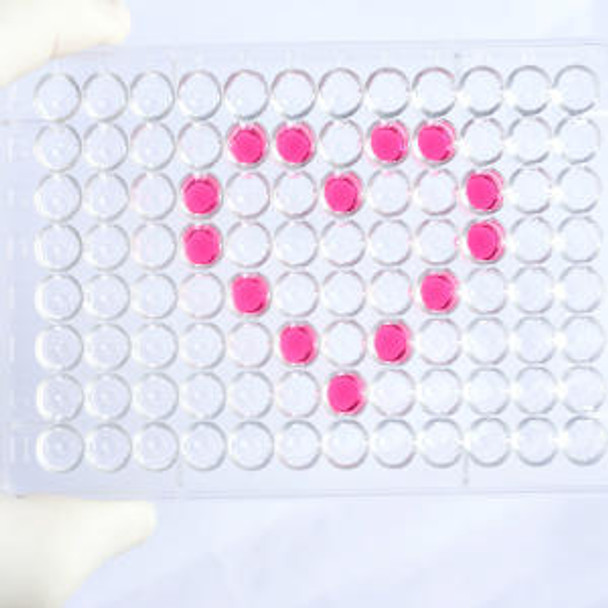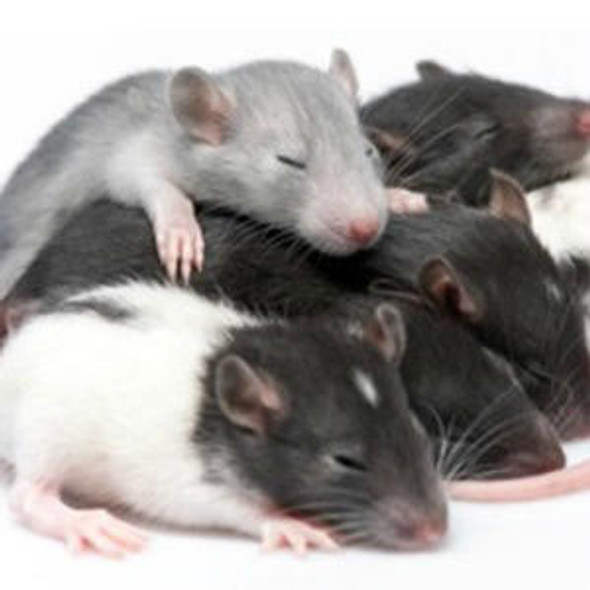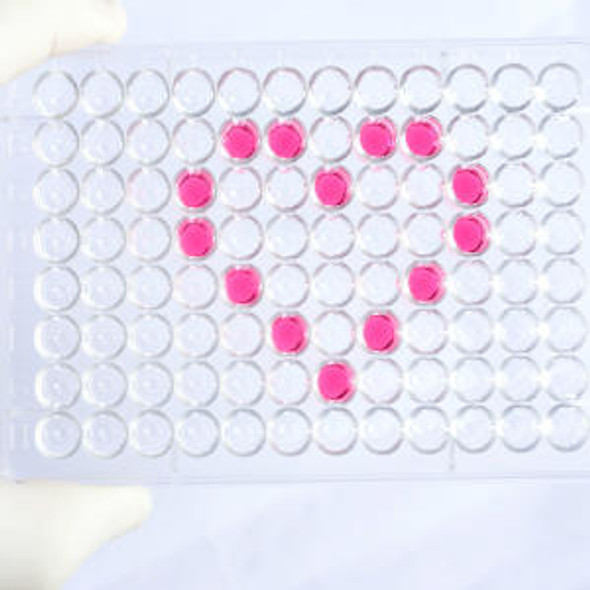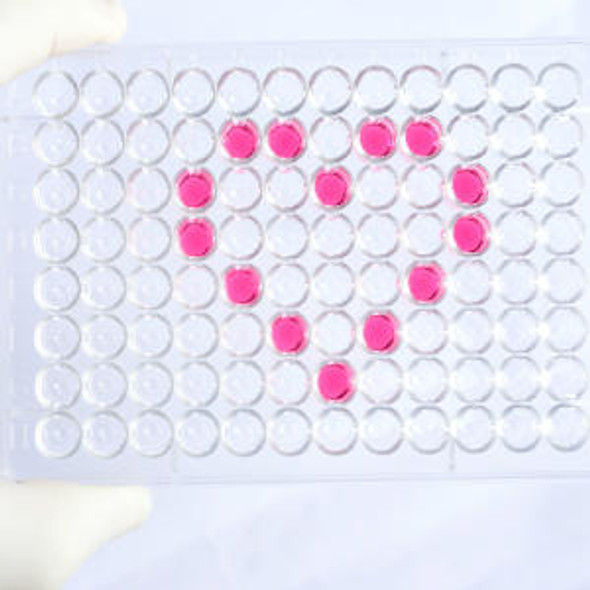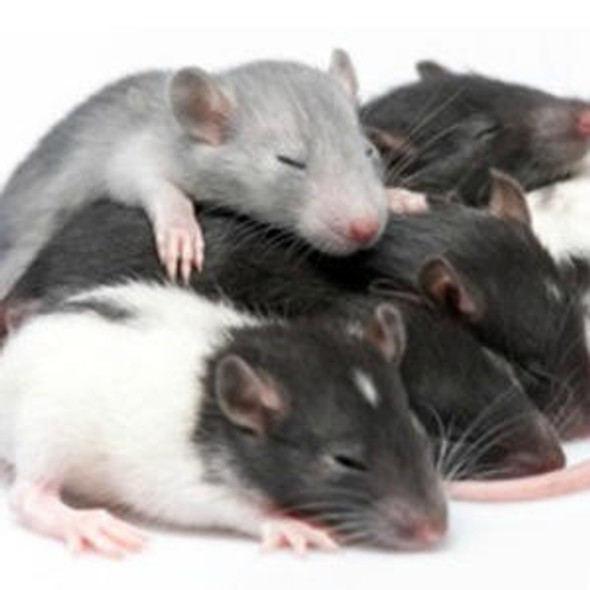Human Macrophage colony-stimulating factor 1 receptor (CSF1R) ELISA Kit
- SKU:
- HUEB1807
- Product Type:
- ELISA Kit
- Size:
- 96 Assays
- Uniprot:
- P07333
- Range:
- 31.2-2000 pg/mL
- ELISA Type:
- Sandwich
- Synonyms:
- MCSFR
- Reactivity:
- Human
Description
| Product Name: | Human Macrophage colony-stimulating factor 1 receptor (CSF1R) ELISA Kit |
| Product Code: | HUEB1807 |
| Alias: | Macrophage colony-stimulating factor 1 receptor, CSF-1-R, Proto-oncogene c-Fms, CSF1R, FMS, CSF-1-R, 2.7.10.1, Proto-oncogene c-Fms, CD115 |
| Uniprot: | P07333 |
| Reactivity: | Human |
| Range: | 31.2-2000 pg/mL |
| Detection Method: | Sandwich |
| Size: | 96 Assay |
| Storage: | Please see kit components below for exact storage details |
| Note: | For research use only |
| UniProt Protein Function: | CSFR: an oncogenic tyrosine kinase receptor for CSF-1 (M-CSF). Drives growth and development of monocytes. Binding of CSF-1 induces receptor dimerization, activation and autophosphorylation of cytoplasmic tyrosine residues used as docking sites for SH2-containing signaling proteins. There are at least five major tyrosine autophosphorylation sites. Two point mutations seen in 10-20% of patients with acute myeloid leukemia, chronic myelomonocytic leukemia or myelodysplasia. One mutation appears to be both somatic and germline, and disrupts Cbl binding and receptor turnover. v-fms lacks the Cbl binding site and causes feline leukemia. Mutations may also develop after chemotherapy for lymphoma. A distinct point mutation was found in some cases of hepatocellular carcinoma and related to increased expression, and another mutation was found in 2 of 40 patients with idiopathic myelofibrosis. Expression is elevated in breast tumors and cell lines, and expression in xenografts and transgenic mice has been correlated with xenograft growth and breast cancer development. Inhibitors: Ki-20227 and other Kit/PDGFR inhibitors. |
| UniProt Protein Details: | Protein type:Kinase, protein; Membrane protein, integral; EC 2.7.10.1; Protein kinase, tyrosine (receptor); Oncoprotein; Protein kinase, TK; TK group; PDGFR family Chromosomal Location of Human Ortholog: 5q32 Cellular Component: cell surface; integral to plasma membrane; intracellular; plasma membrane Molecular Function:ATP binding; cytokine binding; macrophage colony stimulating factor receptor activity; protein homodimerization activity; protein phosphatase binding Biological Process: axon guidance; cell proliferation; cytokine and chemokine mediated signaling pathway; forebrain neuron differentiation; hemopoiesis; inflammatory response; innate immune response; intercellular junction maintenance; macrophage differentiation; monocyte differentiation; multicellular organismal development; negative regulation of apoptosis; negative regulation of cell proliferation; olfactory bulb development; osteoclast differentiation; peptidyl-tyrosine phosphorylation; phosphatidylinositol metabolic process; phosphoinositide-mediated signaling; positive regulation of cell migration; positive regulation of cell proliferation; positive regulation of osteoclast differentiation; positive regulation of protein amino acid phosphorylation; positive regulation of tyrosine phosphorylation of Stat3 protein; protein amino acid autophosphorylation; regulation of bone resorption; regulation of cell shape; ruffle organization and biogenesis; signal transduction; skeletal muscle development; transmembrane receptor protein tyrosine kinase signaling pathway Disease: Leukoencephalopathy, Diffuse Hereditary, With Spheroids |
| NCBI Summary: | The protein encoded by this gene is the receptor for colony stimulating factor 1, a cytokine which controls the production, differentiation, and function of macrophages. This receptor mediates most if not all of the biological effects of this cytokine. Ligand binding activates the receptor kinase through a process of oligomerization and transphosphorylation. The encoded protein is a tyrosine kinase transmembrane receptor and member of the CSF1/PDGF receptor family of tyrosine-protein kinases. Mutations in this gene have been associated with a predisposition to myeloid malignancy. The first intron of this gene contains a transcriptionally inactive ribosomal protein L7 processed pseudogene oriented in the opposite direction. Alternative splicing results in multiple transcript variants. [provided by RefSeq, Dec 2013] |
| UniProt Code: | P07333 |
| NCBI GenInfo Identifier: | 547770 |
| NCBI Gene ID: | 1436 |
| NCBI Accession: | P07333.2 |
| UniProt Secondary Accession: | P07333,Q6LDW5, Q6LDY4, Q86VW7, B5A955, D3DQG2, |
| UniProt Related Accession: | P07333 |
| Molecular Weight: | 33,248 Da |
| NCBI Full Name: | Macrophage colony-stimulating factor 1 receptor |
| NCBI Synonym Full Names: | colony stimulating factor 1 receptor |
| NCBI Official Symbol: | CSF1R |
| NCBI Official Synonym Symbols: | FMS; CSFR; FIM2; HDLS; C-FMS; CD115; CSF-1R; M-CSF-R |
| NCBI Protein Information: | macrophage colony-stimulating factor 1 receptor |
| UniProt Protein Name: | Macrophage colony-stimulating factor 1 receptor |
| UniProt Synonym Protein Names: | CSF-1 receptor (EC:2.7.10.1); CSF-1-R; CSF-1R; M-CSF-R; Proto-oncogene c-Fms; CD_antigen: CD115 |
| Protein Family: | Macrophage colony-stimulating factor 1 receptor |
| UniProt Gene Name: | CSF1R |
| UniProt Entry Name: | CSF1R_HUMAN |
| Component | Quantity (96 Assays) | Storage |
| ELISA Microplate (Dismountable) | 8×12 strips | -20°C |
| Lyophilized Standard | 2 | -20°C |
| Sample Diluent | 20ml | -20°C |
| Assay Diluent A | 10mL | -20°C |
| Assay Diluent B | 10mL | -20°C |
| Detection Reagent A | 120µL | -20°C |
| Detection Reagent B | 120µL | -20°C |
| Wash Buffer | 30mL | 4°C |
| Substrate | 10mL | 4°C |
| Stop Solution | 10mL | 4°C |
| Plate Sealer | 5 | - |
Other materials and equipment required:
- Microplate reader with 450 nm wavelength filter
- Multichannel Pipette, Pipette, microcentrifuge tubes and disposable pipette tips
- Incubator
- Deionized or distilled water
- Absorbent paper
- Buffer resevoir
*Note: The below protocol is a sample protocol. Protocols are specific to each batch/lot. For the correct instructions please follow the protocol included in your kit.
Allow all reagents to reach room temperature (Please do not dissolve the reagents at 37°C directly). All the reagents should be mixed thoroughly by gently swirling before pipetting. Avoid foaming. Keep appropriate numbers of strips for 1 experiment and remove extra strips from microtiter plate. Removed strips should be resealed and stored at -20°C until the kits expiry date. Prepare all reagents, working standards and samples as directed in the previous sections. Please predict the concentration before assaying. If values for these are not within the range of the standard curve, users must determine the optimal sample dilutions for their experiments. We recommend running all samples in duplicate.
| Step | |
| 1. | Add Sample: Add 100µL of Standard, Blank, or Sample per well. The blank well is added with Sample diluent. Solutions are added to the bottom of micro ELISA plate well, avoid inside wall touching and foaming as possible. Mix it gently. Cover the plate with sealer we provided. Incubate for 120 minutes at 37°C. |
| 2. | Remove the liquid from each well, don't wash. Add 100µL of Detection Reagent A working solution to each well. Cover with the Plate sealer. Gently tap the plate to ensure thorough mixing. Incubate for 1 hour at 37°C. Note: if Detection Reagent A appears cloudy warm to room temperature until solution is uniform. |
| 3. | Aspirate each well and wash, repeating the process three times. Wash by filling each well with Wash Buffer (approximately 400µL) (a squirt bottle, multi-channel pipette,manifold dispenser or automated washer are needed). Complete removal of liquid at each step is essential. After the last wash, completely remove remaining Wash Buffer by aspirating or decanting. Invert the plate and pat it against thick clean absorbent paper. |
| 4. | Add 100µL of Detection Reagent B working solution to each well. Cover with the Plate sealer. Incubate for 60 minutes at 37°C. |
| 5. | Repeat the wash process for five times as conducted in step 3. |
| 6. | Add 90µL of Substrate Solution to each well. Cover with a new Plate sealer and incubate for 10-20 minutes at 37°C. Protect the plate from light. The reaction time can be shortened or extended according to the actual color change, but this should not exceed more than 30 minutes. When apparent gradient appears in standard wells, user should terminatethe reaction. |
| 7. | Add 50µL of Stop Solution to each well. If color change does not appear uniform, gently tap the plate to ensure thorough mixing. |
| 8. | Determine the optical density (OD value) of each well at once, using a micro-plate reader set to 450 nm. User should open the micro-plate reader in advance, preheat the instrument, and set the testing parameters. |
| 9. | After experiment, store all reagents according to the specified storage temperature respectively until their expiry. |
When carrying out an ELISA assay it is important to prepare your samples in order to achieve the best possible results. Below we have a list of procedures for the preparation of samples for different sample types.
| Sample Type | Protocol |
| Serum | If using serum separator tubes, allow samples to clot for 30 minutes at room temperature. Centrifuge for 10 minutes at 1,000x g. Collect the serum fraction and assay promptly or aliquot and store the samples at -80°C. Avoid multiple freeze-thaw cycles. If serum separator tubes are not being used, allow samples to clot overnight at 2-8°C. Centrifuge for 10 minutes at 1,000x g. Remove serum and assay promptly or aliquot and store the samples at -80°C. Avoid multiple freeze-thaw cycles. |
| Plasma | Collect plasma using EDTA or heparin as an anticoagulant. Centrifuge samples at 4°C for 15 mins at 1000 × g within 30 mins of collection. Collect the plasma fraction and assay promptly or aliquot and store the samples at -80°C. Avoid multiple freeze-thaw cycles. Note: Over haemolysed samples are not suitable for use with this kit. |
| Urine & Cerebrospinal Fluid | Collect the urine (mid-stream) in a sterile container, centrifuge for 20 mins at 2000-3000 rpm. Remove supernatant and assay immediately. If any precipitation is detected, repeat the centrifugation step. A similar protocol can be used for cerebrospinal fluid. |
| Cell culture supernatant | Collect the cell culture media by pipette, followed by centrifugation at 4°C for 20 mins at 1500 rpm. Collect the clear supernatant and assay immediately. |
| Cell lysates | Solubilize cells in lysis buffer and allow to sit on ice for 30 minutes. Centrifuge tubes at 14,000 x g for 5 minutes to remove insoluble material. Aliquot the supernatant into a new tube and discard the remaining whole cell extract. Quantify total protein concentration using a total protein assay. Assay immediately or aliquot and store at ≤ -20 °C. |
| Tissue homogenates | The preparation of tissue homogenates will vary depending upon tissue type. Rinse tissue with 1X PBS to remove excess blood & homogenize in 20ml of 1X PBS (including protease inhibitors) and store overnight at ≤ -20°C. Two freeze-thaw cycles are required to break the cell membranes. To further disrupt the cell membranes you can sonicate the samples. Centrifuge homogenates for 5 mins at 5000xg. Remove the supernatant and assay immediately or aliquot and store at -20°C or -80°C. |
| Tissue lysates | Rinse tissue with PBS, cut into 1-2 mm pieces, and homogenize with a tissue homogenizer in PBS. Add an equal volume of RIPA buffer containing protease inhibitors and lyse tissues at room temperature for 30 minutes with gentle agitation. Centrifuge to remove debris. Quantify total protein concentration using a total protein assay. Assay immediately or aliquot and store at ≤ -20 °C. |
| Breast Milk | Collect milk samples and centrifuge at 10,000 x g for 60 min at 4°C. Aliquot the supernatant and assay. For long term use, store samples at -80°C. Minimize freeze/thaw cycles. |

